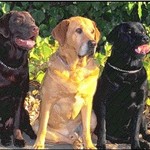
28th January - forestryjournal.co.uk
CORRECT signage, clearly set out routes, and timely intervention are some of the suggestions outlined in new guidance on how to welcome dog walkers into woodlands.
Forest managers are also being urged to create “dogs on leads” zones and to observe the public and their pets as part of efforts to ensure recreational woodland users can enjoy nature safely.
Dog walking is the main recreational activity for 21% of all woodland visitors, according to new advice from the Forestry Commission.
In a post, the government agency wrote: “Building strong relationships with dog walkers is essential for effective management of woodland visitors.
“As well as applying good access management for all visitors to your woodland, there are other considerations for visitors with dogs.
“Consider the overall design principles of your woodland, and how they relate to the visitors you want to influence.
“Good woodland design and maintenance can reduce potential conflicts.”
These can include:
strategic design of path infrastructure, such as how wide paths are and how they link together
good design and upkeep of paths, vegetation, gates and fences
planning and maintaining any car parking and other facilities or infrastructure, such as dog waste bins
Practical advice offered by the FC includes:
emphasise routes you’d prefer dog walkers to use to steer them away from sensitive areas: do this by enhancing path surfaces, signage and information
mow and place brash and fallen trees along paths to create ‘natural fencing’ to keep dog walkers on paths: this is important if spaces are opened temporarily by felling, thinning or coppicing
review existing management and access plans to see if there are future opportunities in planting and felling cycles to develop a more suitable network of paths
decide if ‘desire lines’ can be part of the path network: these paths show where people naturally walk, and including them can reduce the need for extra management
choose the least restrictive option: most dog walkers prefer a dog off-lead exercise, including ‘off duty’ assistance dogs
have a ‘dogs on leads zone’ in sensitive areas: it’s more effective than expecting dogs to be on leads throughout the woodland



